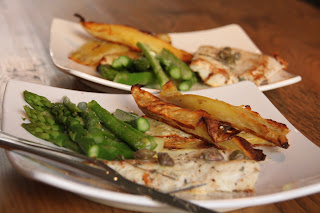 We love this recipe and have it all the time, its a great crowd pleaser, and also very healthy!
We love this recipe and have it all the time, its a great crowd pleaser, and also very healthy! I remember the first time we had these rolls - we had just arrived in Siem Reap, Cambodia, to see the amazing Angkor Wat. We sat down in a restaurant for a drink and a bite to eat, incidentally it was supposed to be a butterfly garden, covered by a huge net. But in true Asian style there was not a butterfly to be found! The menu presented us with two options of springrolls: springrolls and fresh springrolls... Well of course we ordered the fresh ones, we wouldn't want stale ones now would we? What arrived before us was quite different to what we expected - these were not your usual Chinese style deep fried springrolls, they were delicate rice paper wraps filled with delicious, fresh, fragrant herbs and ingredients. They soon became a favourite on our travels.
If serving these for friends, the easiest is to lay out all the ingredients, and then let your friends pick their ingredients and 'roll their own'. Trust me it goes down very well :) I make mine with chicken, but you can easily use pork as well, or make them vegetarian.
Ingredients:
Chicken:- 1 chicken breast per person, sliced
- Olive Oil
- Your favourite Chinese sauce - I find the Woolworths 'Wok Sauce' works superbly, but you could also use some garlic and ginger, soy sauce or any stir fry type sauce.
- 1 cup (8 oz) hoisin sauce (if sauce is thick, add about 1/4 cup warm water to reach desired consistency) - I get this from my favourite Asian food store. It really works well with this dish!
- 1/4 cup smooth peanut butter
- 1 Tbs rice vinegar
- 2 garlic, crushed
- 1 minced Thai chili, or more for desired spiciness
- About 4 rice paper wrappers per person. Again, from my favourite Asian food store. The round ones work best, I use 'Erawan Brand'
- Fresh herbs: mint, coriander, basil, or any others you like
- Lettuce/rocket
- Cucumber, cut into long slices
- Bean sprouts
- Rice Vermicelli noodles, soaked in boiled water, then drained. About 1/2 a small pack per 4 people.
Other optional extras: (less traditional):
- Avocado (my personal favourite!)
- Carrot, cut into very thin strips
- Spring Onion
- Mange Tout/Snap Peas/Baby Corn cut into strips
- Soy or fish sauce for dipping
- Sweet Chilli Sauce
Method:
Pan fry the chicken in a little olive oil, add the wok sauce just before the end. The chicken can be served warm or cool, depending on your preference. Don't forget to soak the noodles as well.
Make the Hoisin Peanut sauce: mix all ingredients together, and add a little warm water if it seems too thick. But don't make it too thin or it will run out of your rolls! Rather try it first.
Lay out all your ingredients on the table, including a very large flat bowl/casserole dish half filled with water. I find cold water works fine.
Take your first rice paper wrapper and place it in the water, turning if it doesn't entirely fit, for about 5 seconds, then remove and place on your plate. it will continue to soften so don't soak too long!
Layer whatever ingredients you like in the middle of the roll, but resist the urge to overfill! The hoisin sauce is supposed to be used as a dipping sauce, but we find it easiest to put it in the roll as well.
Fold in the sides, then roll the whole thing until it forms a neat parcel. Cut in half if you like, or just bite into it whole, enjoy!











